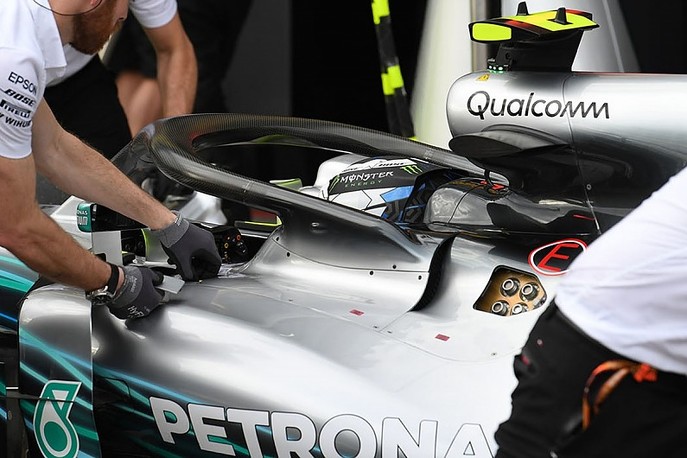How Mercedes is dealing with F1 engine cooling headaches in 2018

Lewis Hamilton's warnings about his engine getting too hot during his pursuit of Sebastian Vettel at the Australian Grand Prix has highlighted how on the edge cooling requirements are in Formula 1.
Teams well know that the less cooling required, the more aerodynamic performance they can achieve from a car featuring more closed-off bodywork, but that brings a risk of things overheating.
In Mercedes' case with its W09 in Melbourne, its car had sufficient cooling for when it was running in clear air, but that became more marginal when running behind a rival.
The balancing act over cooling will be even tougher in Bahrain this weekend, with temperatures much higher than in Australia.

Mercedes has opted for a clever way of installing its halo, with the boat tail section at the rear of the safety structure crafted into a cooling exit (red arrow, below).
It's not dissimilar to the solution used when cooling demands were at the most extreme last season (inset, below), as the team exchanged the normal blank panel alongside the cockpit for one that included two vertical cooling slits when it was needed.
What has changed this year is the fact that the cooling slot appears to be more permanent - with interchangeable panels fitted (blue arrow, above) depending on what the individual cooling requirements are.
For Australia, the team opted to run the W09 with a blank panel, relying on only the new exit and the main cooling exit at the rear of the car.
Both Lewis Hamilton and Valtteri Bottas noted how difficult it was to follow other cars and keep their power unit in the optimum temperature window, leading to them having to back off and pull out of the wake of cars ahead of them on the straights.
Lewis Hamilton said: "I was on the limit, pushing, but always nervous of damaging the engine at the same time.
"I cooled it down and then when I got relatively close, it came back. So I was constantly being pushed and pulled."
Valtteri Bottas added: "I couldn't put pressure on other cars, I could only follow for two laps and then back off and try again."
Bahrain will offer a fascinating insight into how much aerodynamic performance Mercedes is willing to sacrifice in the bid to ensure it gets its cooling spot on.
Zdroj: autosport.com
Diskusia k článku
Najnovšie galérie
































 Kenjiro
Kenjiro 
 Katarína
Katarína 
 Mikko
Mikko 
 Carlos
Carlos 
 Jozef
Jozef